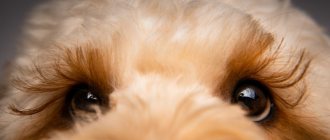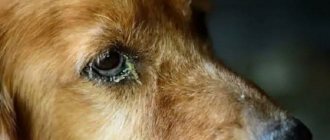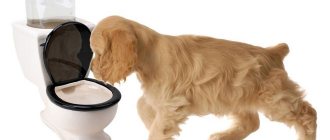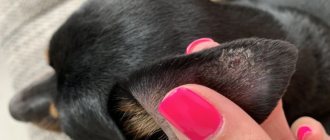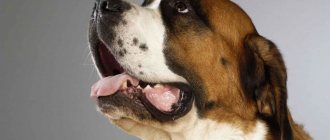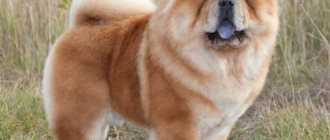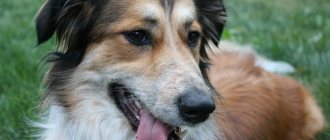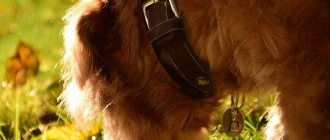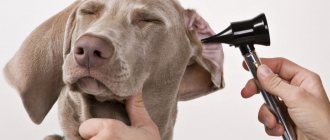Kinds
Most often, the owner can notice the first signs of dandruff when scratching and stroking the pet’s back, as well as the croup area. Manifestations of dandruff can be found behind the ears and on the neck. The appearance of the scales that appear on the skin will help to understand the causes of dandruff and methods of its treatment.
- If dead particles of epithelium easily fall off the fur, then we can safely say that dandruff is dry . This manifestation is accompanied by general dryness of the skin and dehydration. Dull fur is common with this type of dandruff.
- If the pet's fur fat, has an unpleasant odor, is often disheveled, or locally thinned out, then it can be stated skin disease. In this case, dandruff is small yellowish sticky lumps that get stuck on the fur and are difficult to comb out. The dog itches all the time, because skin diseases are accompanied by unbearable itching.
You can also divide dandruff by color:
- White - particles of dead skin. Often, white dandruff appears when hair is falling out or actively falling out.
- Black - so-called pseudo-dandruff. This is not exfoliation of the skin, but of blackheads and clotted blood. Such spots can appear on the skin due to serious disruption of the sebaceous glands and improper combing.
When combing, you can damage the bumps protruding on the surface of the skin, and they “fall off”. This gives the impression that it is black dandruff. This is a sign of hormonal imbalance, which can cause baldness.Common fleas are often confused with black dandruff!
- Yellow - usually a companion to seborrheic dermatitis.
- Red (pink) is not essentially dandruff, but pieces of skin that exfoliate from an infected, inflamed area of the skin due to dermatitis.
REFERENCE: The word “dandruff”, like many medical terms, is of Latin origin, and translated means “bran”
Associated symptoms
In addition to profusely flaking scales, other accompanying symptoms may indicate that your pet is unwell. If they are detected, it is recommended to contact a veterinary clinic as soon as possible.
Severe itching
If your dog has dandruff and constantly itches, biting its teeth into the skin until it bleeds, show it to the doctor. Bloody scratches that appear with intense itching are fraught with secondary infection. If diagnosis is delayed, you will have to deal not only with the root cause, but also with complications.
Sores of various types
In inflamed areas, ulcers, papules, rashes and vesicles may form. Over time, these sores damage deeper and deeper layers, opening the way for pathogenic microorganisms.
Hair loss
Symmetrical loss of tufts of hair is characteristic of hormonal disorders, parasitosis and seborrhea. In the second case, in addition to abundant hair loss, their thinning and a strong unpleasant odor are noted.
Baldness in patches
Patchy baldness is the main symptom of fungal infection. Over time, individual bald spots merge together, worsening the overall picture. If hair loss is associated with an autoimmune disease, then the hairs disappear forever. The hips, sides and groin of the animal are particularly affected.
Causes
Why does this problem arise? Dandruff itself does not always clearly indicate a malfunction in the dog’s body. There can be many reasons for its appearance, from a simple change in food or an unsuitable indoor microclimate, to serious damage to the skin by mites. To understand where dandruff comes from, you need to observe your pet.
Why does dandruff appear in dogs?
- Seasonal dandruff on the back during hair loss (molting) is a common phenomenon.
Most dogs live in apartments with central heating, which greatly affects air humidity. As soon as the air becomes drier than usual, shedding begins, which is accompanied by dry dandruff. Usually it goes away when the coat change ends. To alleviate your pet’s condition, you need to comb its fur more often, and also use conditioner when bathing. You can purchase an air humidifier - this will be useful not only for your pet, but also for other inhabitants of the apartment. - If the dog is constantly itching , then dandruff on the coat becomes even more noticeable, especially on the back. There can be many reasons for itching. This is either a food allergy, or a reaction to the bites of blood-sucking insects, or the first manifestations of eczema, seborrhea or other types of dermatitis. Skin parasites can also make themselves felt by unbearable itching.
- Stress . Dogs react differently to the world around them, and some are more susceptible to stressful situations. Stress can be anything - separation from the owner, boredom, fear, and much more. A dog can easily begin to itch due to nervousness, and it is the owner’s duty to protect his friend from nervous shocks.
- Scratching, sores, thickening of the skin in these places, severe oily dandruff, in which a lot of hair climbs and falls out - an unambiguous signal from the dog’s body about a skin disease. This could be atopic dermatitis, allergies, seborrhea, scabies, demodicosis and many other infectious and unpleasant diseases for the dog. If your pet is in this condition, you should never postpone a visit to the veterinarian!
- If the dog behaves as usual , but dandruff is normal for it, then it is worth thinking about how high-quality nutrition the pet receives.
Economy class food, food from the master's table, fatty, salty, sweet - all this should be prohibited. When choosing food, it is best to pay attention to premium food that contains the optimal amount of essential nutrients and vitamins. A good alternative to ready-made food can be preparing your own food for your dog. - A nonspecific cause of dandruff in a dog can be improper hair care, too frequent or, conversely, too infrequent washing, or inappropriate shampoo.
REFERENCE: The PH level of a dog’s skin is 8, while a human’s is 5.5. Instead of the owner's shampoo and conditioner, when bathing your four-legged friend, you need to use special products intended only for dogs.
How to get rid of dandruff in a dog
All methods used are aimed at strengthening the immune system, relieving itching and restoring metabolic processes. It is especially important to eliminate all factors that increase the detachment of the epidermis.
Reviewing your diet and adding vitamins
First of all, it is necessary to make changes to the diet, making it more varied and balanced. When feeding naturally, you should control the calorie-protein-fats-carbohydrates (calories-protein-fats-carbohydrates) and be sure to give your pet vitamins. It is almost impossible to get them from food alone.
In ready-made feeds, the norms are already calculated in advance and indicated on the packaging. It is enough for owners to adhere to these recommendations and not skimp on quality by refusing bulk or low-quality pellets.
Treatment of skin diseases
Drug treatment for dandruff in dogs depends on the diagnosis. Depending on the cause, the animal may be prescribed the following medications:
- sedatives that suppress nervous tension;
- antiparasitic, destroying ecto- and endoparasites;
- antihistamines and glucocorticosteroids that suppress allergic reactions;
- antibiotics and antimycotic agents that fight bacteria and fungi;
- anti-inflammatory, necessary to eliminate inflammation;
- immunostimulants and vitamins that strengthen the immune system.
If the reason lies in hormonal imbalance, then the four-legged patient undergoes mandatory castration. After removal of the reproductive organs, hormone levels gradually return to normal.
Shampoos and sprays
To eliminate itching, use Lactaderm, Tropiclin and Doctor shampoos based on tar, salicylic acid and sulfur. They have a calming and softening effect, but quite often cause an allergic reaction. Before use, it is recommended to apply a portion of the product to a small area of skin to ensure that there is no intolerance to the incoming components.
Suitable sprays include Stop Itching, Frontline and Stronghold. The first drug is used to treat any skin pathologies, and the second and third are used to treat parasitosis.
Folk remedies
Some folk remedies can also help cope with excessive peeling, itching and inflammation of the skin. These include:
- sea buckthorn, burdock and olive oils, eliminating the dry type of pathology;
- decoctions of nettle, chamomile and burdock, softening the skin;
- a mixture of essential oils (3-5 drops of lavender, eucalyptus and tea tree per 50 ml of almond oil) that destroys fleas and ticks.
You should consult your veterinarian before using these products. Incorrect dosage can lead to irritation, rashes and other allergic reactions.
Itching Relievers
All antipruritic drugs are divided into fast-acting and slow-acting drugs. The former are suitable for emergency care when the exact diagnosis is not yet known. When using the latter, the result may be absent during the first few weeks, so they are prescribed as a permanent treatment.
In addition to shampoos and sprays, you can purchase drugs in the form of tablets and injection solutions. Here it is better to build on the characteristics of your pet and the recommendations of the veterinarian.
Treatment
How to get rid of dandruff? In order to select adequate treatment, it is important to find out the cause of its occurrence. You shouldn’t do this on your own; it’s best to trust a veterinarian who can professionally examine the dog, take all the necessary tests and skin tests.
When a diagnosis is made, it is much easier to act - the owner just needs to build on it.
How to withdraw:
- What to do if your dog itches like a mangy pig? Kill the parasites! It is necessary not only to bathe the dog using special shampoos, but also to disinfect everything that has ever touched the dog. Brushes and combs should either be thrown away or boiled.
- The dog is stressed . It is important to understand whether the trouble was a one-time occurrence, or whether the animal is subjected to constant stress. The peace and safety of the dog is entirely in the hands of the owner.
- Simple dry skin, then you need to take measures to moisturize it. You can use balms-rinses for dogs, or herbal decoctions; the fur and skin should be massaged with a soft comb or brush.
- Dermatological diseases, it is important not only to consult a doctor on time, but also to follow all his instructions.
By the way, dandruff is a very strong allergen, so asthmatics should refrain from interacting with a dog that has a lot of dander.
And one more thing: it doesn’t matter where exactly the dandruff is - on the back, ears, tail or neck, the set of measures of what to do, treatment and causes will be the same!
Shampoos
How to treat dandruff simply and cheaply: every owner regularly bathes his pet, so if dandruff occurs, it is imperative to change the shampoo to a more suitable one.
- Such a shampoo should contain emollient components, for example, aloe, oats or vitamin A. These can be found in the brands Espree, Fitoelita, 8in1.
- If you suspect skin parasites, then you should pay attention to anti-itch shampoos with an insecticidal effect . Hartz Rid Flea & Tick shampoo with oats, panthenol and vegetable oils showed good results in the fight against parasites.
- Shampoo for dogs with sensitive skin is also in the line.
- Antifungal shampoos for dogs: Nizoral, Imaverol, Doctor. The latest domestic drug is also good for combating skin mites.
Mud fight: how often and with what can you wash your dog?
Vitamins
What vitamins and supplements should you give your dog:
- dried seaweed - a rich source of microelements, normalizes metabolism, improves pigmentation of the outer integument;
- nettle - its finely chopped leaves are added to food (both fresh, after processing with boiling water, and dried) as a source of vitamins to improve wool growth;
- ground flaxseed is a healthy supplier of fatty acids. Grind them in a coffee grinder and periodically add the resulting powder to the dog’s usual food;
- Wheat germ is a storehouse of vitamins B and E and will improve the condition of the skin. In winter, you can sprout wheat grains on the windowsill and treat your pet to them.
Folk remedies
What to do if your pet has dandruff? You can turn to folk knowledge! To treat dandruff and related problems, you can use herbal decoctions.
A decoction of chamomile will help soothe irritated skin, and herbs such as wormwood, yarrow or tansy will repel parasites from the dog’s bedding.
BUT: treatment of dandruff should be carried out under the strict supervision of a veterinarian, and medicinal herbs can be used as additional therapy, but do not replace drug treatment prescribed by a doctor.
What is dandruff
Peeling of the skin is a natural process, but when it becomes pathological, we talk about the appearance of dandruff. These are flaky or dusty scales formed as a result of increased exfoliation of epidermal cells. Usually a dog's peeling spreads everywhere, but there are “favorite” places: back, tail, ears, stomach, neck. It is believed that the appearance of seborrhea is provoked by the fungi Malassezia furfur, which are habitual inhabitants of the skin.
Often dandruff (synonymous with seborrhea) is accompanied by baldness in certain areas. The reasons for this phenomenon lie in infectious and autoimmune processes or are caused by external factors.
Preventive actions
Of course, it is best not to treat the disease, but to prevent it in advance. To summarize, we can say that all skin diseases, be it dandruff, itching or inflammation, are caused either by internal health problems of the animal or by parasites.
- Preventing diseases is quite simple; it is only important to monitor your pet’s diet, feed it with high-quality food, treat it for parasites in a timely manner and keep an eye on where your four-legged friend walks.
- The psychological component is no less important. You need to play with the dog more, communicate with it, train it. Such a social animal as a dog does not know how to be alone.
Recommendations for the owner
During the treatment process, it is important to properly care for your pet. This is an integral part of any treatment.
Rules of care:
- Review the diet, diversify it, add vitamin complexes, purchase premium hypoallergenic food.
- Regularly bathe and comb your pet, avoid the formation of tangles and matted fur. During the molting period, combing is carried out daily, using special brushes and a furminator.
It is worth purchasing a humidifier and turning it on regularly, especially in winter.- When choosing shampoos at a pet supply store, give preference to formulations with antiseborrheic substances.
With proper care, the animal is less likely to suffer from skin diseases.
Cheyletiellosis
Cheyletiellosis is a skin disease named after its causative agent, the Cheyletiella mite. It is also called stray or wandering dandruff. There are many varieties of this mite, and it feels great on the skin of cats and dogs, as well as rabbits, chinchillas and other furry neighbors of humans. This small parasite feeds on tissue fluid, piercing the skin, which subsequently itches severely.
IMPORTANT: The tick is contagious to humans, but it is not capable of living on human skin for a long time. But even a short contact is enough to provide the owner of a sick dog with unpleasant itchy skin rashes.
The tick is a parasite, which means it cannot exist without a host. The period of “independent life” of a female tick lasts up to 10 days, and the male lives only 2 days. Eggs laid in a dog's bedding will be viable for about a week.
How to recognize?
The popular name for this disease is “stray dandruff”, since the mites are very similar to flakes of dead skin cells. Moving from place to place, they create the illusion of dandruff moving, which can frighten the owner. Sometimes diagnosing cheyletiellosis in a dog is difficult, especially if the owner regularly bathes and combs the dog's fur.
There are a number of symptoms by which this disease can be identified.
- Copious flakes of dandruff,
- Excessively oily skin
- Tousled and oily fur,
- Partial hair loss
- Skin redness,
- Obsessive itching and scratching.
ATTENTION: The tick can live in the nostrils of the animal, so the alarm signal can be the pet's sneezing and discharge from its nose.
To be fair, it is worth noting that these symptoms are very similar to the symptoms of many other skin diseases. A veterinarian can determine cheyletiellosis by scraping the skin and conducting a laboratory test.
How to get sick?
Dogs are social creatures, so it is not difficult for them to become infected with cheyletiellosis. It is enough to simply play with a sick dog, and sometimes just lie down on the bedding on which the sick animal was previously lying.
Long-haired dog breeds are more susceptible to the disease, as are dogs with weak immune systems. You can also become infected after visiting a groomer if the latter does not pay due attention to sterilizing his tools and hygiene.
Is it contagious to humans?
Cheyletiellosis is easily transmitted to the owner of a sick dog, and is localized in places of contact with the dog, most often on the hands. Fortunately, the parasite cannot live for long on human skin and dies quickly enough, so specific therapy is not necessary. If you do not comb the affected areas, you can avoid skin damage and associated infections. Emollient creams or a soda solution will help cope with itching.
How to remove?
How to treat this infection? First of all, it is worth remembering that only a veterinarian can make a correct diagnosis, and he must prescribe appropriate treatment for cheyletiellosis. You shouldn’t delay going to the doctor, because a parasite on the skin causes itching and scratching, and scratching, as you know, is a direct path to infection.
If there are other animals living in the house with a sick dog, then everyone will have to be treated for ticks. Long-haired dogs will have to be cut, because this makes treatment much easier. The course of treatment for wandering dandruff, i.e. Cheyletiella mite life is long – about 8 weeks.
- It is important to combine treatments for cheyletiellosis with constant wet cleaning of the house, otherwise re-infection cannot be avoided. All bedding, furniture covers, curtains and even bedding should be disinfected to reduce the risk to zero.
- Dogs are bathed using acaricidal shampoos (for example, “Dana”), and tick eggs are carefully combed out of their fur, since the drugs destroy only adult individuals. In addition, the tick can go into hibernation mode and become active after all the procedures have been completed, so combing is necessary.
- After bathing and brushing, you need to apply drops to the withers . Veterinarians usually prescribe Dana drops, Advantix, Advocate and similar drugs.
- Sulfur ointment can be very effective in the fight against scratching , which is completely harmless to the pet even if swallowed.
- In case of severe disease, the veterinarian may prescribe subcutaneous injections of drugs , depending on the condition of the animal.
Seborrhea or seborrheic dermatitis
Seborrhea is a typical problem for the following breeds: Cocker Spaniel, West Highland White Terrier, German Shepherd, Shar Pei.
Seborrhea is excessive oily skin and/or its rapid growth. In a dog suffering from seborrhea, the skin can grow, creating successive layers of skin 2-3 times faster than in a healthy dog. The top layer of skin is actually dead and is called the keratinized layer or stratum corneum, consisting of thin scales, completely keratinized (keratinized), capable of peeling off and thus detaching.
The cause of skin seborrhea in a dog is quite difficult to determine, as is the origin of any dermatitis. Some scientists are inclined to believe that this disease is of a genetic nature; others say that seborrhea develops as a secondary disease against the background of dysfunction of the sebaceous glands.
Dysfunction manifests itself in excessive activity of the sebaceous and sweat glands, and is accompanied by inflammation.
Symptoms
- Most often, at the initial stage, seborrhea manifests itself as dry or oily dandruff.
- a distinct dog smell appears , even after bathing. If the symptoms are left unattended at this stage, over time, redness and scratching will appear on the dog’s body, the skin will crack, and the claws will become brittle.
- A secondary infection occurs precisely at this moment, because the owner cannot convince the dog not to itch, and the infection spreads precisely through scratched, injured skin.
- Seborrheic dermatitis can be caused by several other factors, such as allergies. In this case, the veterinarian will treat the underlying cause.
Photo
Seborrhea of the edges of the ears
Fat
Since seborrhea manifests itself precisely in the form of dysfunction of the sebaceous glands, its signs are looked for where the dog has the most of them, namely, along the spine. You need to be wary if you find:
- Dandruff and dry skin,
- Greasy dull wool,
- Redness on the skin.
If you suspect seborrhea, you need to carefully examine the dog and check all skin folds and folds, because it is in these places that the infection begins.
Is it possible to get infected?
Despite the terrifying appearance of a sick animal, it is not dangerous to surrounding people and animals. The cause of seborrheic dermatitis lies internally, and it cannot be infected.
How to treat?
- Treatment of seborrheic dermatitis should be comprehensive and include, first of all, veterinary diagnostics . After taking tests, the doctor will determine whether there is any pathology of the internal organs that could cause a skin disease.
- Doctors then test the dog for fungus, parasites, or bacterial infection . Tests can also be used to determine whether a dog has allergies . If no diseases were found during diagnosis, then treatment of primary seborrhea is prescribed.
Unlike secondary seborrhea, primary seborrhea is considered an incurable disease, and therapy in this case will be aimed at improving the condition of the skin and preventing relapses.
Secondary seborrhea usually goes away on its own after the root cause is eliminated.
In both cases, it is important to know which drugs are used for treatment:
- For hair and skin care, antiseborrheic shampoos , which should be prescribed by a doctor based on the condition of the animal’s skin. The most universal can be considered “Tropiclin” and “Doctor” for oily seborrhea, and “Medicinal”, “Agrovetzaschita”, “Globalvet” for dry seborrhea. Your veterinarian may prescribe a special fluconazole shampoo for a fungal infection. ATTENTION: Shampoos with fluconazole cannot be used more than twice a week and longer than 3-4 weeks!
- After washing your dog, you should use conditioners with lanolin or oil for additional moisture. You can use special antipruritic ointments , they will significantly alleviate your pet’s condition.
- If an infection is associated with seborrheic dermatitis, then in this case the doctor will prescribe oral antibiotics, most often drugs containing amoxicillin. IMPORTANT: After a course of antibiotics, it is imperative to take a course of probiotics to support the dog’s digestive tract.
Diet
Since seborrhea is, in principle, incurable, it is important to choose a diet for your four-legged friend, which he must adhere to throughout his life. If the diet is chosen successfully, then seborrhea will go into remission and will not bother the pet.
The diet must include vitamins and mineral supplements, which are responsible for stimulating metabolic processes in the skin. If you wish, you can choose a ready-made diet or cook your dog’s food yourself.
Prevention
To prevent diseases, you should avoid tap water. The pet is given filtered or bottled liquid.
Regular examinations by a veterinarian prevent the development of serious skin diseases and pathologies of internal organs.
You cannot feed your dog food from the table. Many of them can cause allergies; the animal’s body does not secrete enzymes to digest canned food, smoked meats, and chocolate.
It is important to regularly remove worms and ectoparasites from pets. Insects are carriers of various infections and diseases.
If dandruff is found on the animal’s body, you should not self-medicate; the dog should be taken to a veterinarian. Peeling skin is the first symptom of ill health.
Conclusion
To summarize, it is worth noting that:
- Proper grooming of your dog will help prevent skin problems,
- A balanced diet will not only give your pet a thriving appearance, but also health,
- For any problems with the skin and coat, you should immediately contact a veterinarian, otherwise treatment will be difficult and lengthy,
- Comprehensive treatment works best.
Coping with skin diseases is not easy, but if you put in the effort, coupled with love for your pet, the result will be amazing and will not take long to come. How did you treat your pets? Share your stories in the comments!
Diagnostic methods
After an initial examination of the dog’s coat and skin, the veterinarian will prescribe a series of laboratory tests to determine the cause of seborrheic dermatitis or other type of dandruff:
- skin scraping;
- CBC (complete blood count);
- blood test for biochemistry;
- examination of stool and urine;
- biopsy.
The doctor does not necessarily prescribe the entire list of tests. After examination and medical history, he can give a referral for 1-3 studies.
